Recessive Transition Mechanism of Arable Land Use Based on the Perspective of Coupling Coordination of Input–Output: A Case Study of 31 Provinces in China
Abstract
1. Introduction
- In the rapid urbanization wave of China, what are the spatiotemporal changes in the input–output of arable land?
- Is the input and output of arable land highly coupled and sustainable?
- What are the characteristics of arable land use transition among different regions, and what is the enlightenment for the policy of optimizing arable land use mode?
2. Research Area and Methods
2.1. Research Area and Data Source
2.2. Indicator System of Input–Output Analysis on Arable Land
2.3. Evaluation of the Degree of Coupling Coordination Between Input and Output on Arable Land (D_CCIO)
2.3.1. Quantification of the Input–Output Subsystems on Arable Land
2.3.2. Evaluating the Degree of Coupling Coordination of Input and Output (D_CCIO)
2.4. Standardized Deviation Ellipse of the Input and Output on Arable Land
2.5. Analysis of the Spatial Barycenter of Input and Output on Arable Land
3. Result Analysis
3.1. The Spatiotemporal Change in the Input of Production Material on Arable Land
3.1.1. Provincial Input of Production Material
3.1.2. Input of Production Material on Per Unit Area
3.2. The Spatiotemporal Change in the Output on Arable Land
3.2.1. Provincial Output of Crop Yield
3.2.2. Output of Crop Yield Per Unit Area
3.3. The Movement of Spatial Barycenter for the Input and Output on Arable Land
3.4. Degree of Coupling Coordination for the Input–Output on Arable Land
4. Discussion
4.1. Differences in the Recessive Transfortion of Arable Land Use Patterns
4.2. Plenty of Room for Optimizing the Planting System on Arable Land
4.3. Policy Implications of Arable Land Use Transition
5. Conclusions
Author Contributions
Funding
Data Availability Statement
Acknowledgments
Conflicts of Interest
References
- Li, G.; Zhao, Y.; Cui, S. Effects of urbanization on arable land requirements in China, based on food consumption patterns. FOOD Sec. 2013, 5, 439–449. [Google Scholar] [CrossRef]
- Zhang, H.; Zhang, S.; Liu, Z. Evolution and influencing factors of China’s rural population distribution patterns since 1990. PLoS ONE 2020, 15, e0233637. [Google Scholar] [CrossRef]
- Liang, Y.; Lu, W.; Wu, W. Are social security policies for Chinese landless farmers really effective on health in the process of Chinese rapid urbanization? A study on the effect of social security policies for Chinese landless farmers on their health-related quality of life. Int. J. Equ. Health 2014, 13. [Google Scholar] [CrossRef]
- Yang, X.J. China’s Rapid Urbanization. Science 2013, 342, 310. [Google Scholar] [CrossRef]
- Chien, S.-S. Local farmland loss and preservation in China—A perspective of quota territorialization. Land Use Pol. 2015, 49, 65–74. [Google Scholar] [CrossRef]
- Jintao, L.; Li, Y. Influence measurement of rapid urbanization on agricultural production factors based on provincial panel data. Soc.-Econ. Plan. Sci. 2019, 67, 69–77. [Google Scholar] [CrossRef]
- Liu, X.; Zhao, C.; Song, W. Review of the evolution of cultivated land protection policies in the period following China’s reform and liberalization. Land Use Pol. 2017, 660–669. [Google Scholar] [CrossRef]
- Wu, Y.; Shan, L.; Guo, Z.; Peng, Y. Cultivated land protection policies in China facing 2030: Dynamic balance system versus basic farmland zoning. HAB Int. 2017, 69, 126–138. [Google Scholar] [CrossRef]
- Song, W.; Pijanowski, B.C. The effects of China’s cultivated land balance program on potential land productivity at a national scale. Appl. Geogr. 2014, 46, 158–170. [Google Scholar] [CrossRef]
- Zhang, C.; Wang, X.; Liu, Y. Changes in quantity, quality, and pattern of farmland in a rapidly developing region of China: A case study of the Ningbo region. Landsc. Ecol. Eng. 2019, 15. [Google Scholar] [CrossRef]
- Jiao, C.; Chen, L.; Sun, C.; Jiang, Y.; Shen, Z. Evaluating national ecological risk of agricultural pesticides from 2004 to 2017 in China. Environ. Pollut. 2019, 259, 113778. [Google Scholar] [CrossRef]
- Luo, Y.; Yue, H.F.; Li, S.H.; Yi, H.; Zhu, G.P. On the loss regularity of water and fertilizer in sandy soil with abundance of underground water but lack of cultivated layer. IOP Conf. Ser. Earth Environ. Sci. 2019, 346, 012044. [Google Scholar] [CrossRef]
- Shi, C.; Li, J.; Cao, T. Evaluation of the Soil Nutrients of Added Cultivated Land Based on Entropy Weight-Fuzzy Comprehensive Method: A Case Study in Chengcheng County, Shaanxi Province. In Advances in Engineering Research, Proceedings of the 2nd International Conference on Material Science, Energy and Environmental Engineering (MSEEE 2018), Chongqing, China, 16–17 August 2018; Atlantis Press: Amsterdam, The Netherlands, 2018. [Google Scholar]
- Xin, Y.; Yin, G.; Lou, L. Analysis of Cultivated Land Use Heterogeneity Based on the Three-Dimensional Differentiation of Rural Households in Shandong Province. China Land Sci. 2020, 34, 78–85. [Google Scholar] [CrossRef]
- Zou, L.; Liu, Y.; Wang, Y.; Hu, X. Assessment and analysis of agricultural non-point source pollution loads in China: 1978–2017. J. Environ. Manag. 2020, 263, 110400. [Google Scholar] [CrossRef]
- Liu, Y.; Song, W.; Mu, F. Changes in ecosystem services associated with planting structures of cropland: A case study in Minle County in China. PCEA 2017, 102, 10–20. [Google Scholar] [CrossRef]
- Xie, H.; Liu, G. Spatiotemporal differences and influencing factors of multiple cropping index in China during 1998–2012. J. Geog. Sci. 2015, 25, 1283–1297. [Google Scholar] [CrossRef]
- Long, H.; Qu, Y. Land use transitions and land management: A mutual feedback perspective. Land Use Pol. 2018, 74, 111–120. [Google Scholar] [CrossRef]
- Chen, K.; Long, H.; Liao, L.; Tu, S.; Li, T. Land use transitions and urban-rural integrated development: Theoretical framework and China’s evidence. Land Use Pol. 2020, 92, 104465. [Google Scholar] [CrossRef]
- Lyu, X.; Niu, S.; Gu, G.; Peng, W. Conceptual cognition and research framework on sustainable intensification of cultivated land use in China from the perspective of the “New Agriculture, Countryside and Peasants”. J. Nat. Ressour. 2020, 35, 2029–2043. [Google Scholar] [CrossRef]
- Yin, G.; Jiang, X.; Sun, J.; Qiu, M. Discussing the regional-scale arable land use intensity and environmental risk triggered by the micro-scale rural households’ differentiation based on step-by-step evaluation-a case study of Shandong Province, China. Environ. Sci. Pollut. Res. Int. 2020, 27, 8271–8284. [Google Scholar] [CrossRef]
- He, G.; Zhao, Y.; Wang, L.; Jiang, S.; Zhu, Y. China’s food security challenge: Effects of food habit changes on requirements for arable land and water. JCP 2019, 229, 739–750. [Google Scholar] [CrossRef]
- Li, F.; Liu, W.; Lu, Z.; Mao, L.; Xiao, Y. A multi-criteria evaluation system for arable land resource assessment. Environ. Monit. Assess. 2020, 192. [Google Scholar] [CrossRef] [PubMed]
- Xie, H.; Chen, Q.; Wang, W.; He, Y. Analyzing the green efficiency of arable land use in China. Technol. Forecast. Soc. Chang. 2018, 133, 15–28. [Google Scholar] [CrossRef]
- Ouyang, W.; Cai, G.; Huang, W.; Hao, F. Temporal–spatial loss of diffuse pesticide and potential risks for water quality in China. Sci. Total Environ. 2015, 541, 551. [Google Scholar] [CrossRef] [PubMed]
- Duncan, E.G.; O’Sullivan, C.A.; Roper, M.M.; Biggs, J.S.; Peoples, M.B. Influence of co-application of nitrogen with phosphorus, potassium and sulphur on the apparent efficiency of nitrogen fertiliser use, grain yield and protein content of wheat: Review. Field Crops Res. 2018, 226, 56–65. [Google Scholar] [CrossRef]
- Zhao, J.; Ni, T.; Li, J.; Lu, Q.; Fang, Z.; Huang, Q.; Zhang, R.; Li, R.; Shen, B.; Shen, Q. Effects of organic–inorganic compound fertilizer with reduced chemical fertilizer application on crop yields, soil biological activity and bacterial community structure in a rice–wheat cropping system. Appl. Soil Ecol. 2016, 99, 1–12. [Google Scholar] [CrossRef]
- He, H.; Wang, Z.; Guo, L.; Zheng, X.; Zhang, J.; Li, W.; Fan, B. Distribution characteristics of residual film over a cotton field under long-term film mulching and drip irrigation in an oasis agroecosystem. Soil Tillage Res. 2018, 180, 194–203. [Google Scholar] [CrossRef]
- Xu, B.; Wang, F.; Wang, J.; Zhao, S. Establishment and verification of labor demand estimation model in planting industry. Int. J. Agric. Biol. Eng. 2017. [Google Scholar] [CrossRef]
- Luo, X.; Zhang, Z.; Lu, X.; Zhang, L. Topographic Heterogeneity, Rural Labor Transfer and Cultivated Land Use: An Empirical Study of Plain and Low Hill areas in China. Pap. Reg. Sci. 2019. [Google Scholar] [CrossRef]
- Li, X.; Liu, L.; Xie, J.; Wang, Z.; Li, Y. Optimizing the quantity and spatial patterns of farmland shelter forests increases cotton productivity in arid lands. Agric. Ecosyst. Environ. 2020, 292. [Google Scholar] [CrossRef]
- Wu, L.; Wu, X.; Shaaban, M.; Zhou, M.; Zhao, J.; Hu, R. Decrease in the annual emissions of CH 4 and N 2O following the initial land management change from rice to vegetable production. Environ. Sci. Pollut. Res. 2018, 25, 13014–13025. [Google Scholar] [CrossRef] [PubMed]
- Tian, Y.; Zhao, L.; Meng, H.; Sun, L.; Yan, J. Estimation of un-used land potential for biofuels development in (the) People’s Republic of China. Appl. Energy 2009, 86, S77–S85. [Google Scholar] [CrossRef]
- Cheng, X.; Long, R.; Chen, H.; Li, Q. Coupling coordination degree and spatial dynamic evolution of a regional green competitiveness system—A case study from China. Ecol. Indic. 2019, 104, 489–500. [Google Scholar] [CrossRef]
- Zhang, Z.; Li, Y. Coupling coordination and spatiotemporal dynamic evolution between urbanization and geological hazards–A case study from China. Sci. Total Environ. 2020, 728. [Google Scholar] [CrossRef] [PubMed]
- Fu, S.; Zhuo, H.; Song, H.; Wang, J.; Ren, L. Examination of a coupling coordination relationship between urbanization and the eco-environment: A case study in Qingdao, China. Environ. Sci. Pollut. Res. 2020, 27, 23981–23993. [Google Scholar] [CrossRef]
- Zhang, T.; Li, L. Research on temporal and spatial variations in the degree of coupling coordination of tourism–urbanization–ecological environment: A case study of Heilongjiang, China. Environ. Dev. Sustain. 2020, 1–18. [Google Scholar] [CrossRef]
- Lefever, D.W. Measuring Geographic Concentration by Means of the Standard Deviational Ellipse. Am. J. Sociol. 1926, 32, 88–94. [Google Scholar] [CrossRef]
- Yin, S.; Guo, M.; Wang, X.; Yamamoto, H.; Ou, W. Spatiotemporal variation and distribution characteristics of crop residue burning in China from 2001 to 2018. Environ. Pollut. 2020. [Google Scholar] [CrossRef]
- Shi, Y.; Matsunaga, T.; Yamaguchi, Y.; Li, Z.; Gu, X.; Chen, X. Long-term trends and spatial patterns of satellite-retrieved PM2.5 concentrations in South and Southeast Asia from 1999 to 2014. Sci. Total Environ. 2018, 615, 177–186. [Google Scholar] [CrossRef]
- He, Y.; Chen, Y.; Tang, H.; Yao, Y.; Yang, P.; Chen, Z. Exploring spatial change and gravity center movement for ecosystem services value using a spatially explicit ecosystem services value index and gravity model. Environ. Monit. Assess. 2010, 175, 563–571. [Google Scholar] [CrossRef]
- Qu, Y.; Long, H. A framework of multi-disciplinary comprehensive research on recessive farmland transition in China. Acta Geogr. Sin. 2018, 73, 1226–1241. [Google Scholar] [CrossRef]
- Tian, J.; Wang, B.; Zhang, C.; Li, W.; Wang, S. Mechanism of regional land use transition in underdeveloped areas of China: A case study of northeast China. Land Use Pol. 2020, 94, 104538. [Google Scholar] [CrossRef]
- Long, H.; Qu, Y.; Tu, S.; Zhang, Y.; Jiang, Y. Development of land use transitions research in China. J. Geog. Sci. 2020, 30, 1195–1214. [Google Scholar] [CrossRef]
- Zhu, F.; Zhang, F.; Ke, X. Rural industrial restructuring in China’s metropolitan suburbs: Evidence from the land use transition of rural enterprises in suburban Beijing. Land Use Pol. 2018, 74, 121–129. [Google Scholar] [CrossRef]
- Yin, G.; Lin, Z.; Jiang, X.; Yan, H.; Wang, X. Spatiotemporal differentiations of arable land use intensity—A comparative study of two typical grain producing regions in northern and southern China. JCP 2018, 208, 1159–1170. [Google Scholar] [CrossRef]
- Li, S.; Lei, Y.; Zhang, Y.; Liu, J.; Shi, X.; Jia, H.; Wang, C.; Chen, F.; Chu, Q. Rational trade-offs between yield increase and fertilizer inputs are essential for sustainable intensification: A case study in wheat–maize cropping systems in China. Sci. Total Environ. 2019, 679, 328–336. [Google Scholar] [CrossRef]
- Xu, Y.; Li, Z.; Wang, L. Temporal-spatial differences in and influencing factors of agricultural eco-efficiency in Shandong Province, China. Ciência Rural. 2020, 50. [Google Scholar] [CrossRef]
- Kong, X.; Zhang, X.; Lal, R.; Zhang, F.; Chen, X.; Niu, Z. Chapter Two: Groundwater Depletion by Agricultural Intensification in China’s HHH Plains, Since 1980s. Adv. Agron. 2016, 135, 59–106. [Google Scholar] [CrossRef]
- Xin, F.; Xiao, X.; Dong, J.; Zhang, G.; Li, B. Large increases of paddy rice area, gross primary production, and grain production in Northeast China during 2000-2017. Sci. Total Environ. 2019, 711, 135183. [Google Scholar] [CrossRef]
- Liu, C.; Zhou, L.; Jia, J.; Wang, L.; Si, J.; Li, X.; Pan, C.; Li, F. Maize yield and water balance is affected by nitrogen application in a film-mulching ridge–furrow system in a semiarid region of China. Eur. J. Agron. 2014, 52, 103–111. [Google Scholar] [CrossRef]
- Zhang, P.; Xu, S.; Zhang, G.; Pu, X.; Wang, J.; Zhang, W. Carbon cycle in response to residue management and fertilizer application in a cotton field in arid Northwest China. J. Integr. Agric. 2019, 18, 1103–1119. [Google Scholar] [CrossRef]
- Huang, C.; Yang, H.; Li, Y.; Zhang, M.; Lv, H.; Zhu, A.X.; Yu, Y.; Luo, Y.; Huang, T. Quantificational effect of reforestation to soil erosion in subtropical monsoon regions with acid red soil by sediment fingerprinting. Environ. Earth Sci. 2017, 76, 34. [Google Scholar] [CrossRef]
- He, L.; Du, Y.; Wu, S.; Zhang, Z. Evaluation of the agricultural water resource carrying capacity and optimization of a planting-raising structure. Agric. Water Manag. 2021, 243, 106456. [Google Scholar] [CrossRef]
- Wang, J.; Fu, B.; Wang, L.; Lu, N.; Li, J. Water use characteristics of the common tree species in different plantation types in the Loess Plateau of China. Agric. For. Meteorol. 2020, 108020. [Google Scholar] [CrossRef]
- Li, G.; Feng, Z.; You, L.; Fan, L. Re-examining the inverse relationship between farm size and efficiency: The empirical evidence in China. China Agric. Econ. Rev. 2013. [Google Scholar] [CrossRef]
- Jin, Y.; Qian, W.; Wu, B. Off-farm employment and grain production change: New evidence from China. China Econ. Rev. 2020, 63, 101519. [Google Scholar] [CrossRef]
- Wang, Y.; Li, X.; Xin, L.; Tan, M. Farmland marginalization and its drivers in mountainous areas of China. Sci. Total Environ. 2019, 719, 135132. [Google Scholar] [CrossRef]
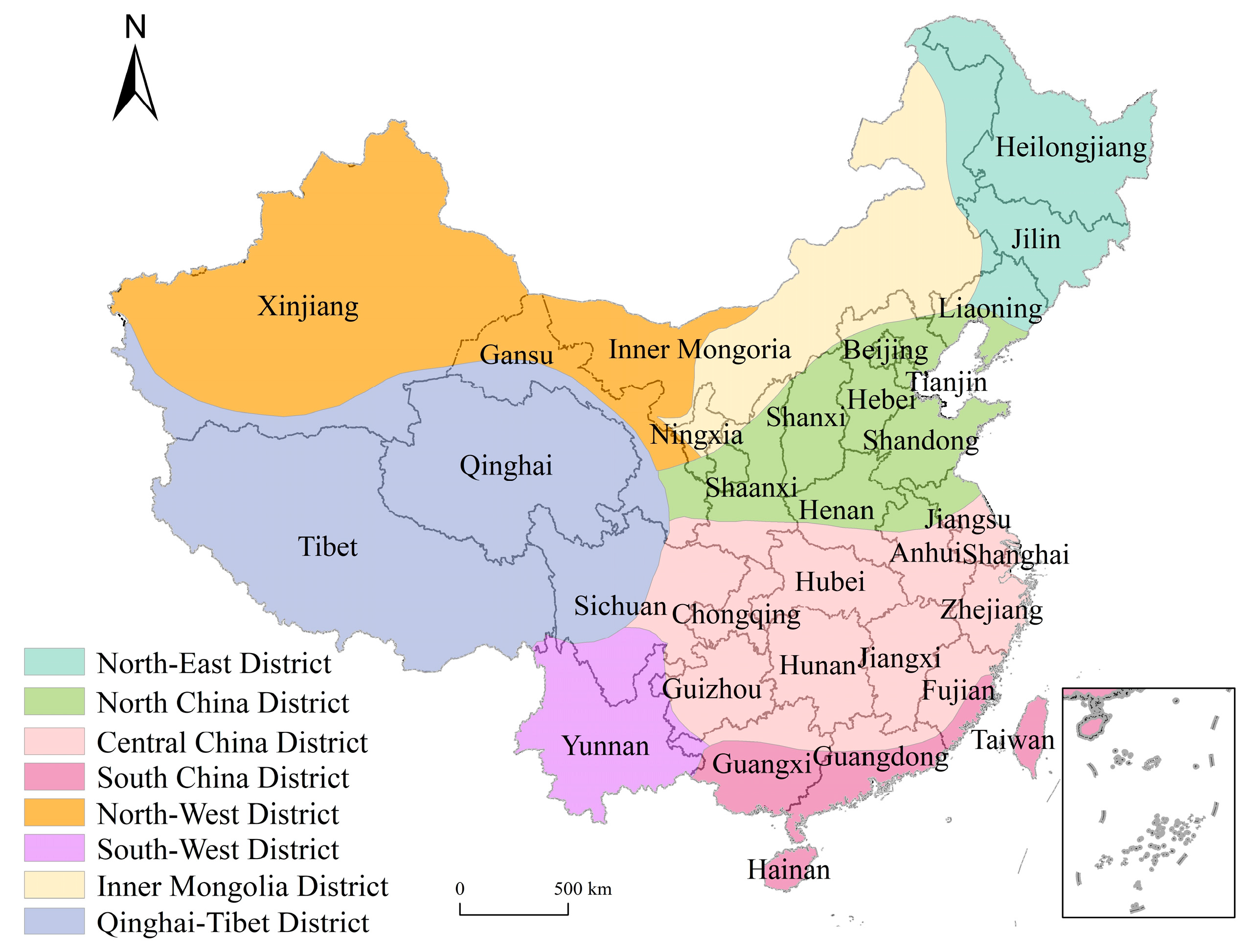
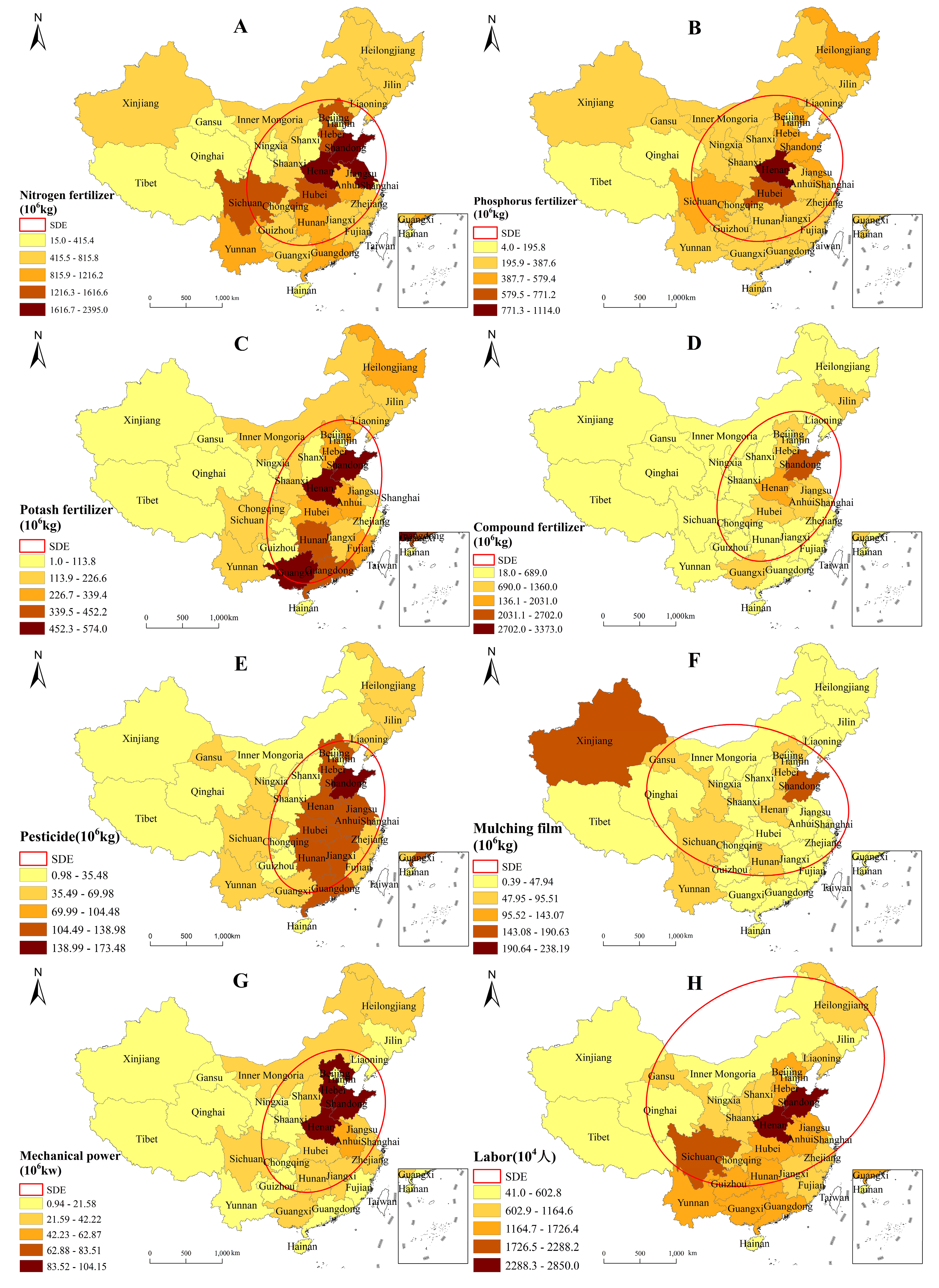
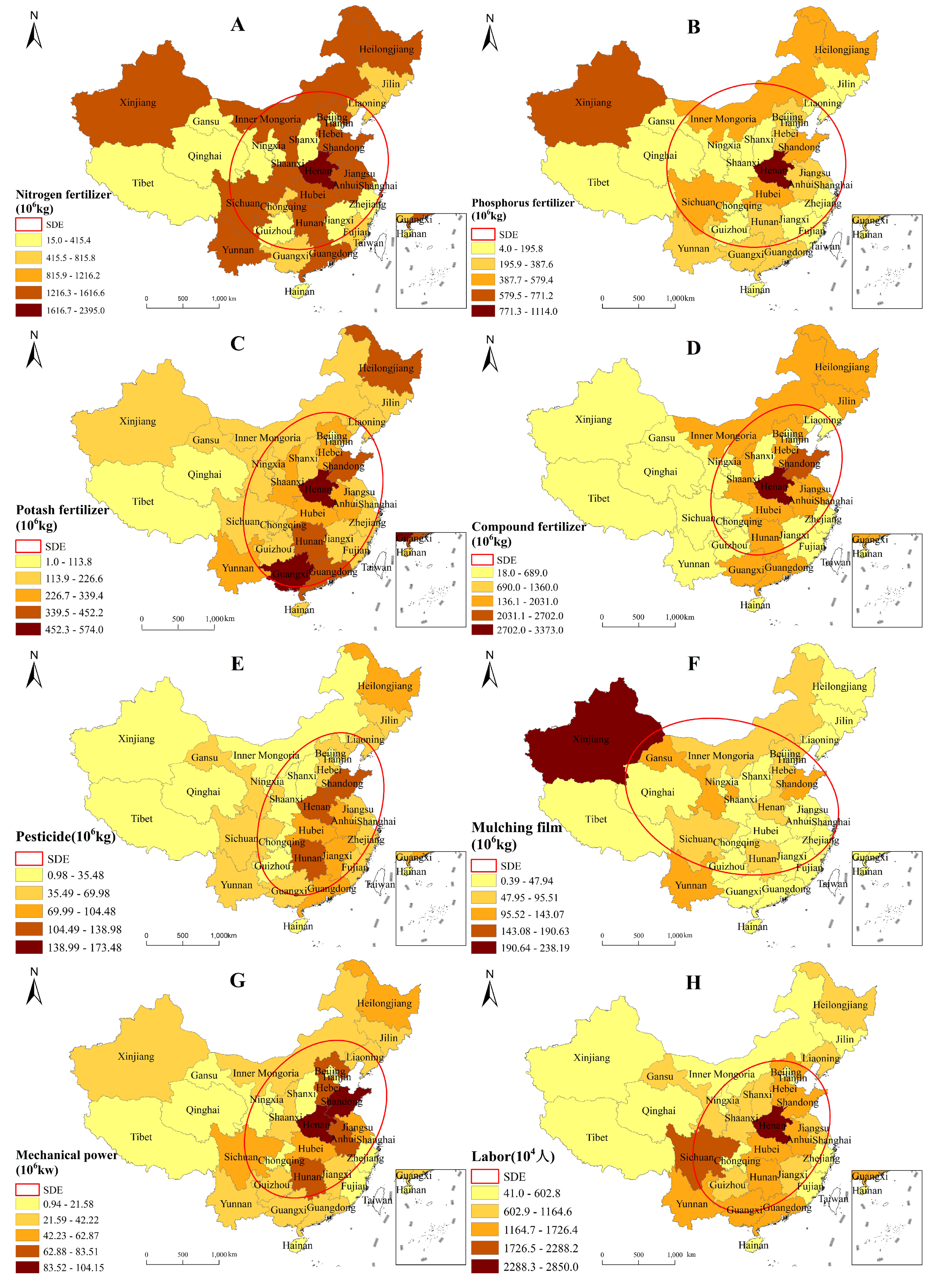
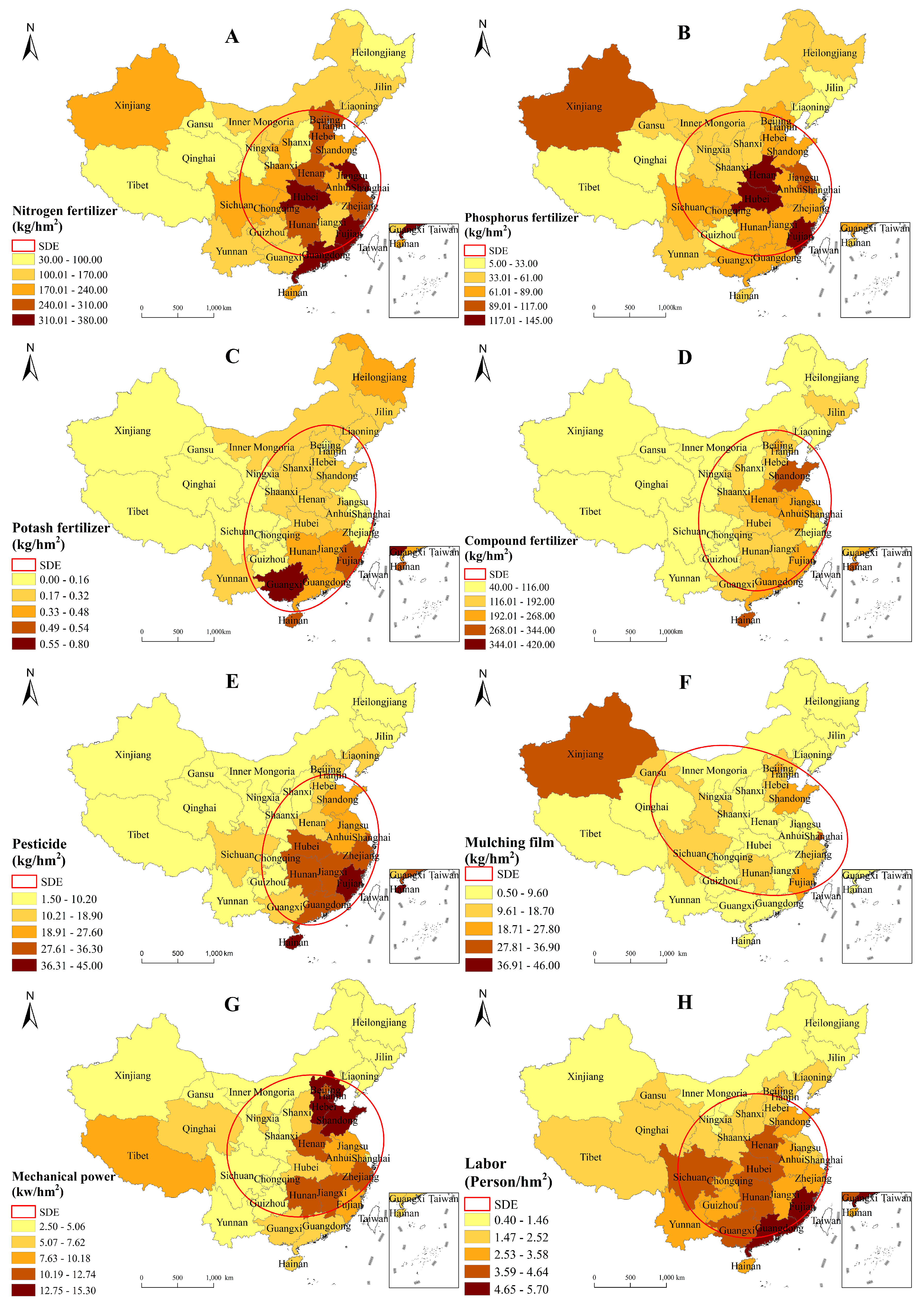
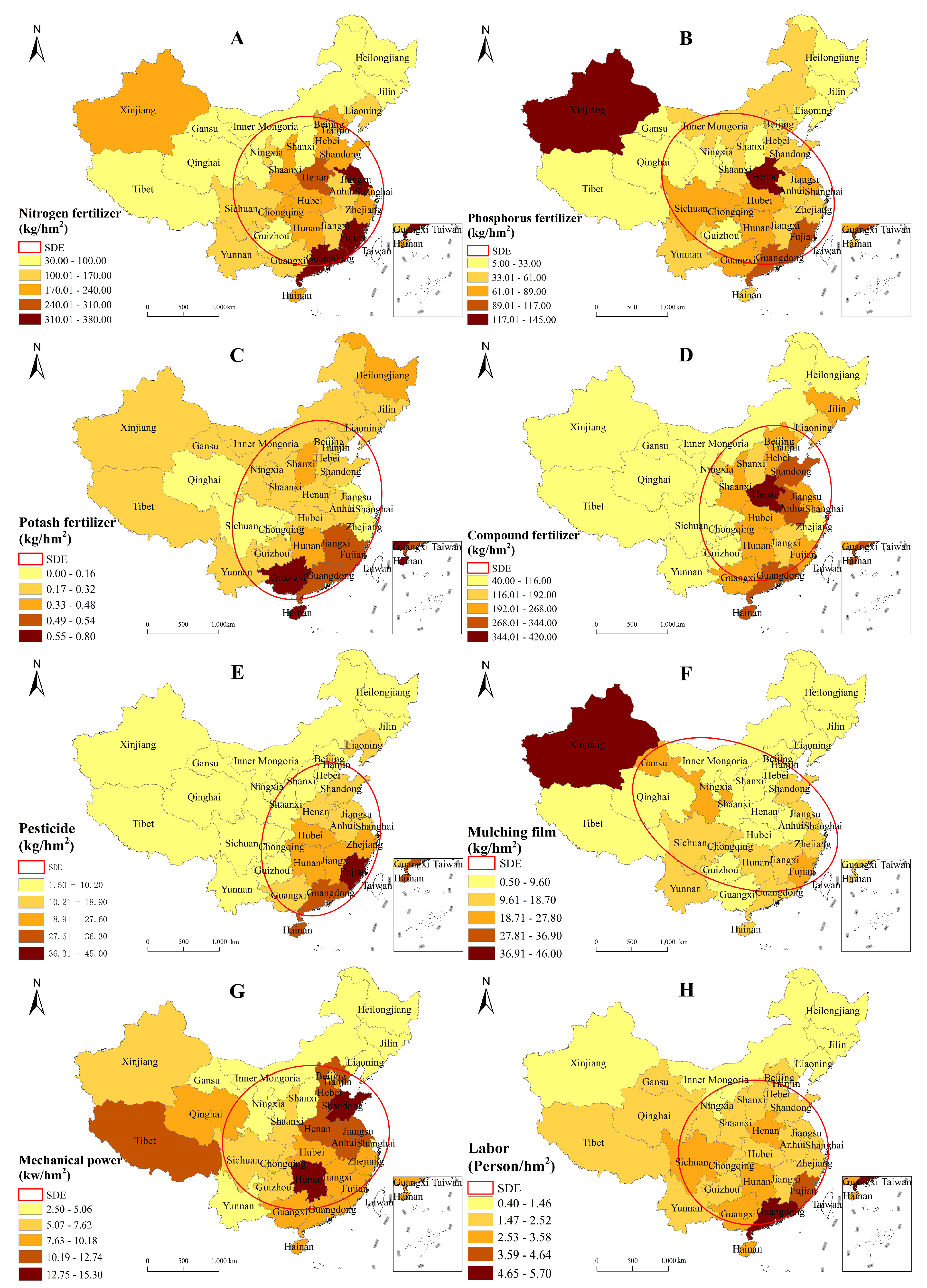
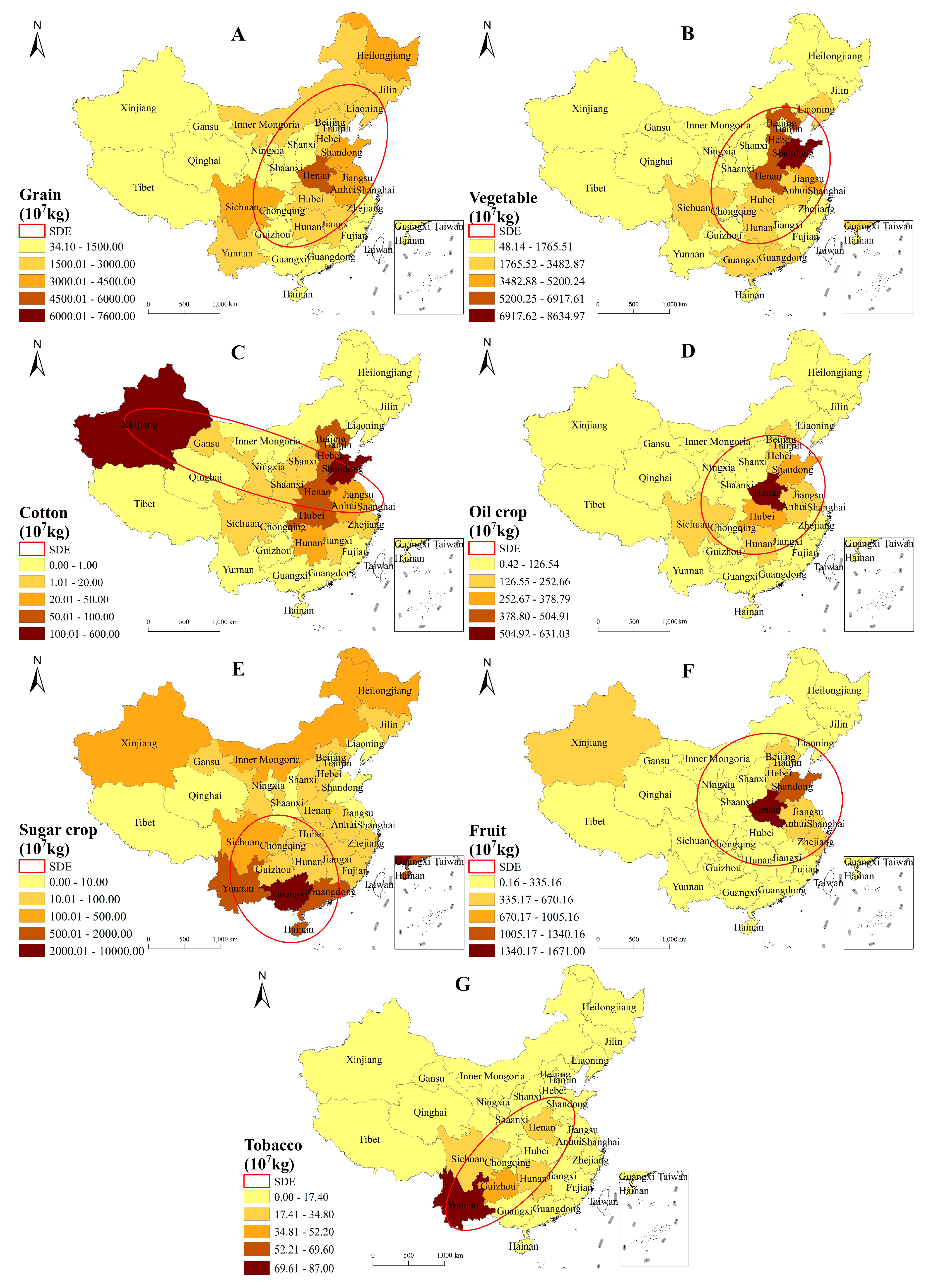
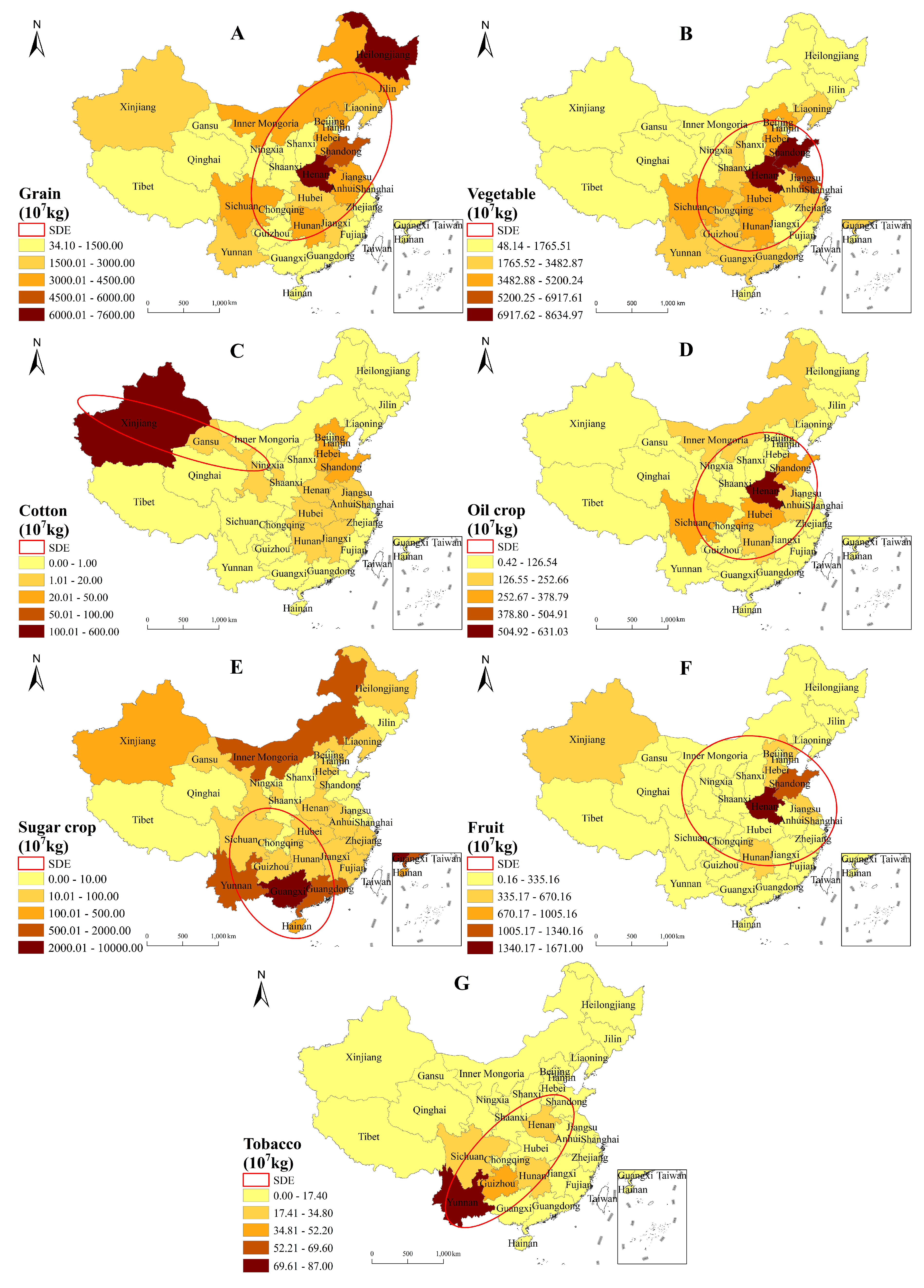
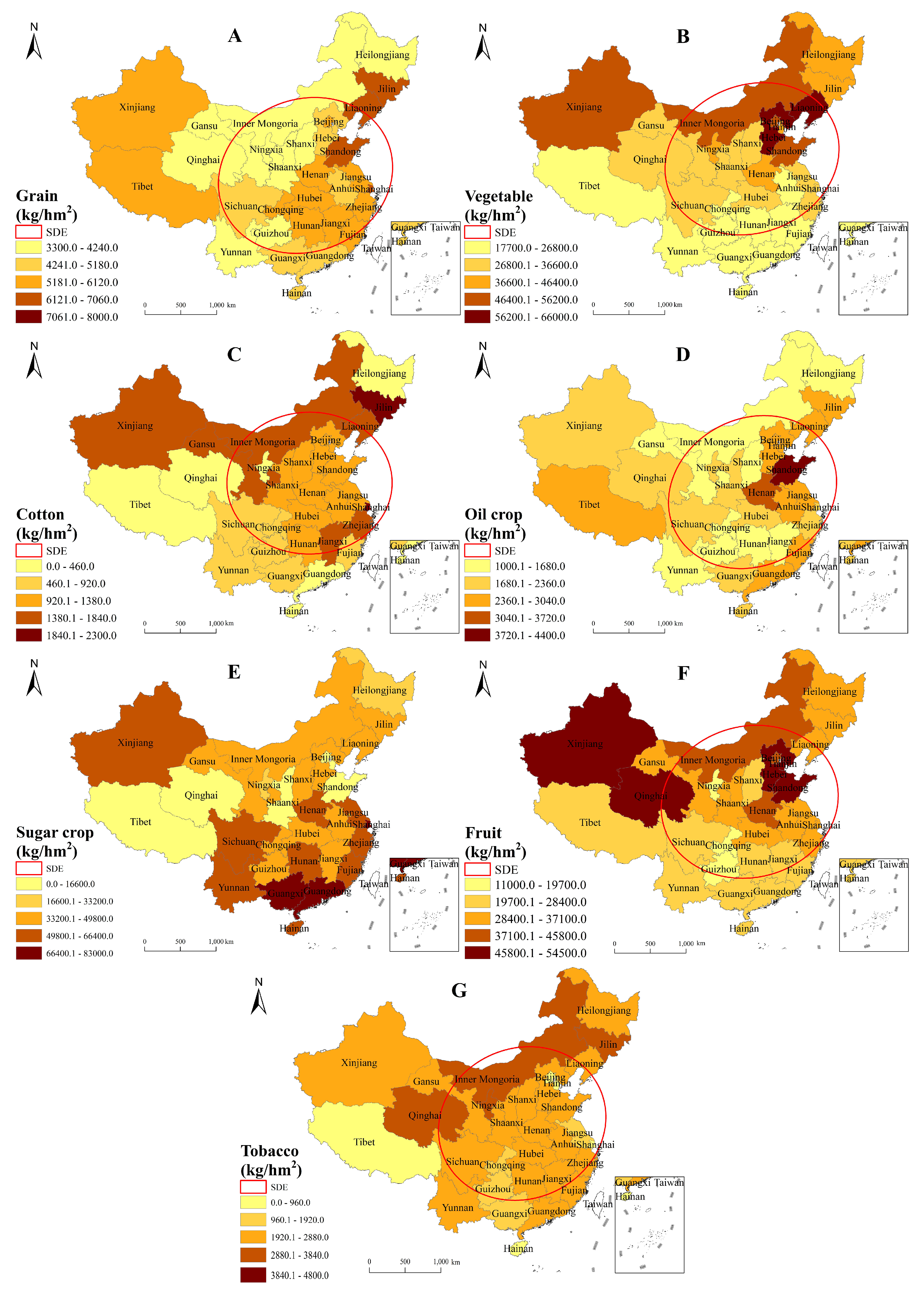
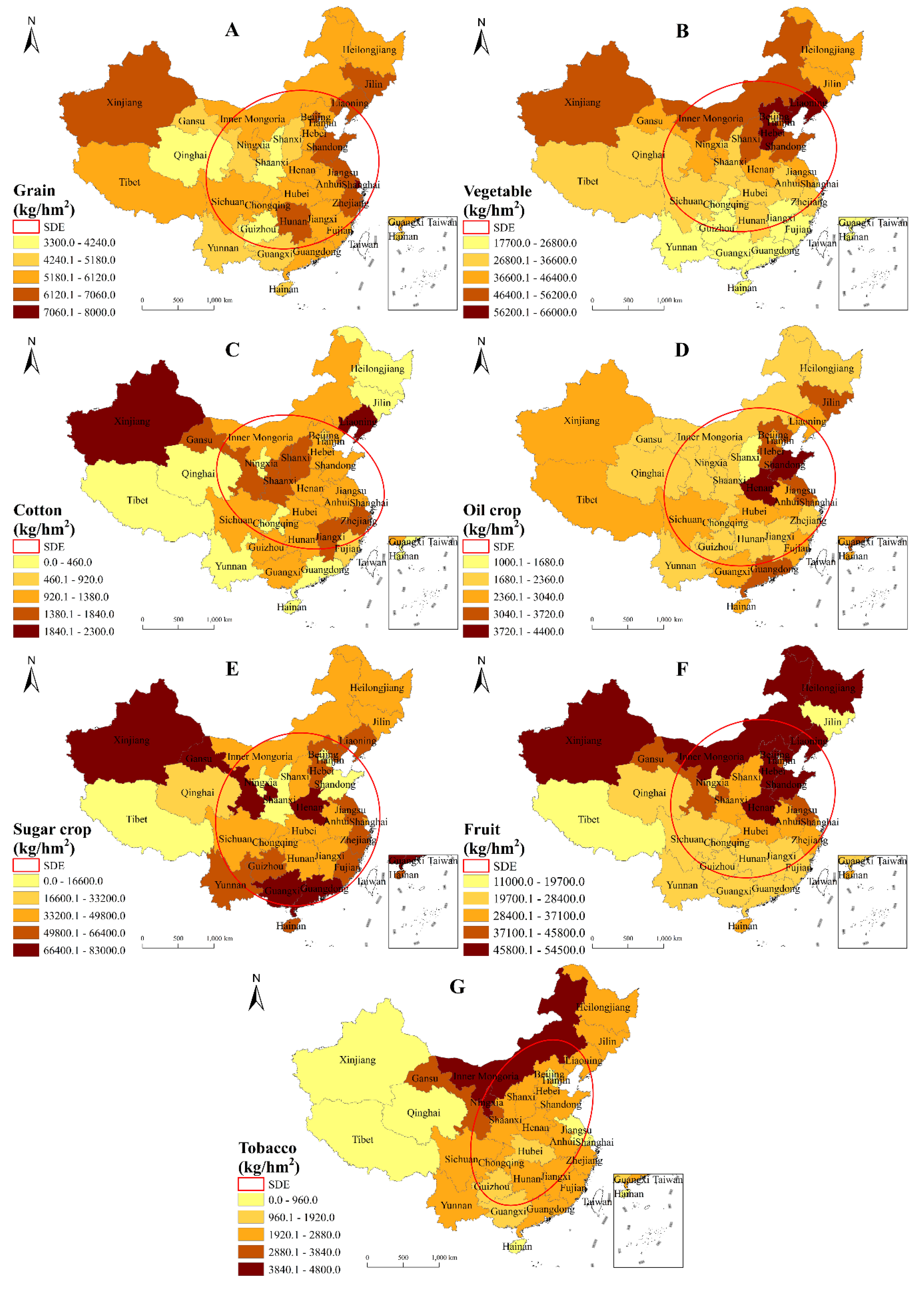
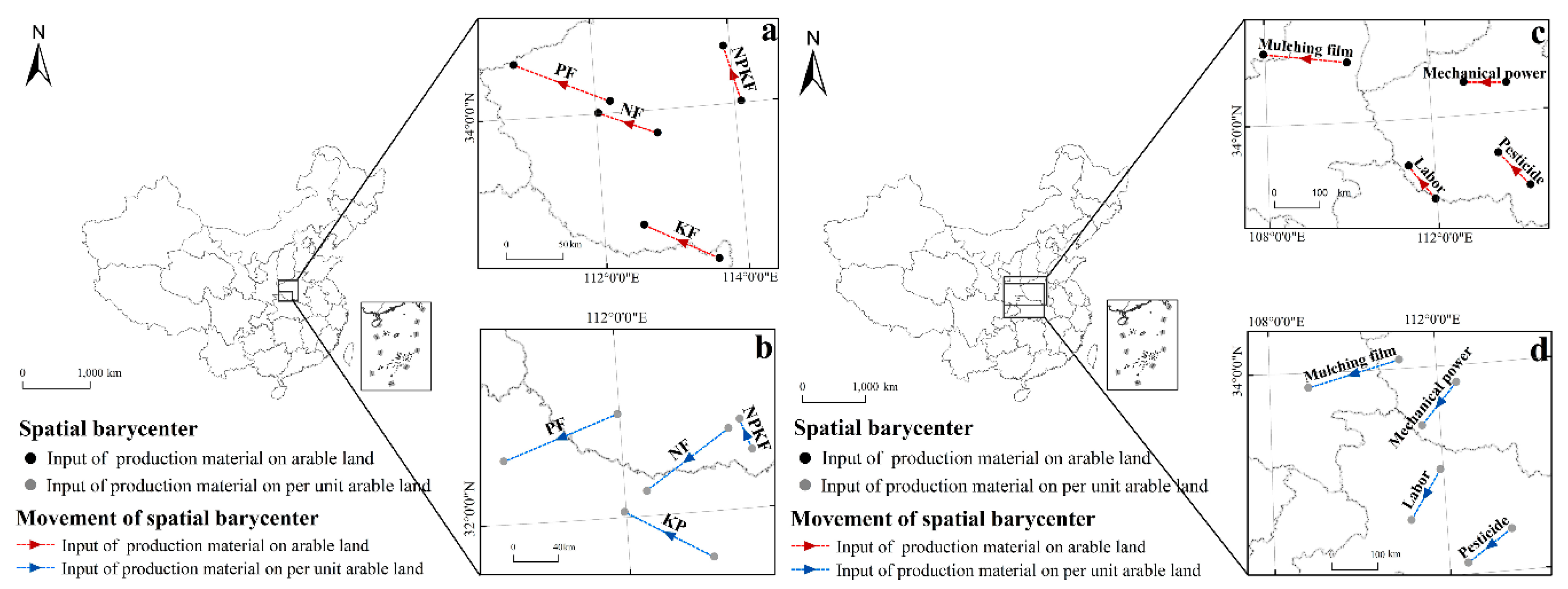
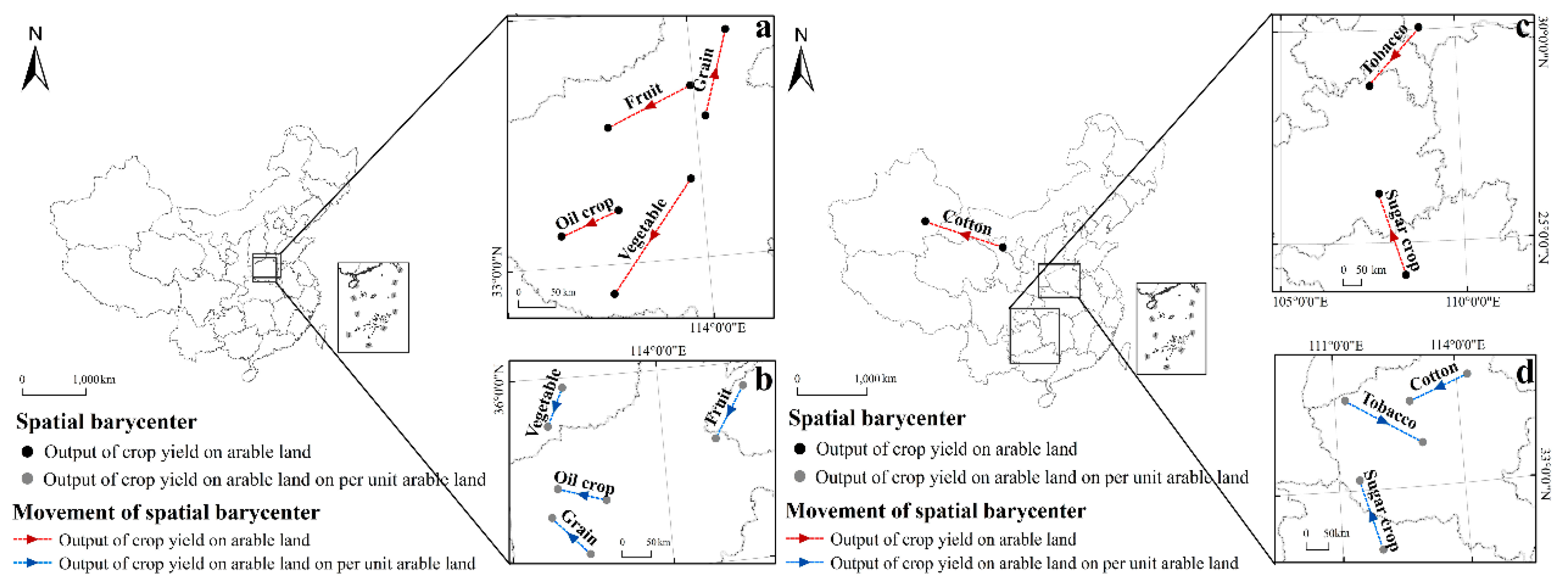

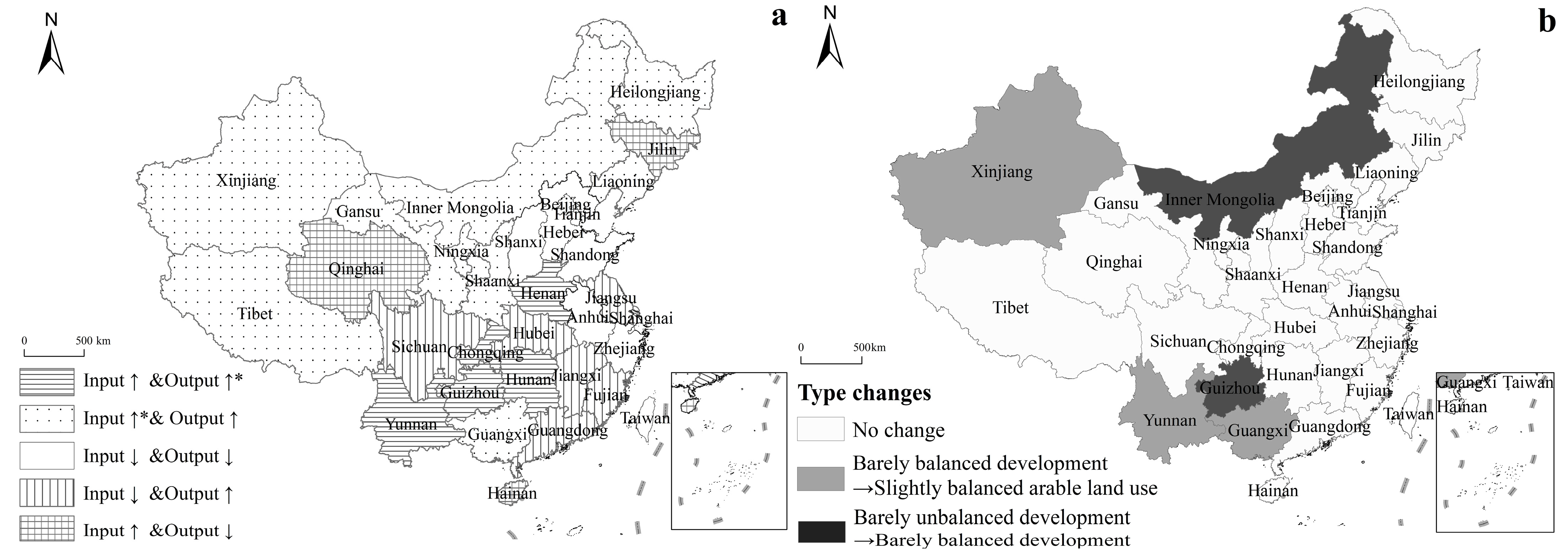
| Subsystem | Content | Subsystem | Content | ||
|---|---|---|---|---|---|
| Input of arable land (I) | Nitrogen fertilizer (kg) | I1 | Output of arable land (O) | Grain (kg) | O1 |
| Phosphorus fertilizer (kg) | I2 | Oil crop (kg) | O2 | ||
| Potash fertilizer (kg) | I3 | Cotton (kg) | O3 | ||
| Compound fertilizer (kg) | I4 | Sugar crop (kg) | O4 | ||
| Mulching film (kg) | I5 | Tobacco (kg) | O5 | ||
| Mechanical power (kg) | I6 | Fruit (kg) | O6 | ||
| Pesticide (kg) | I7 | Vegetable (kg) | O7 | ||
| Labor (person) | I8 |
| Categories | Development Modes between Sub Systems of Input and Output | Grades of D_CCIO | Classes |
|---|---|---|---|
| Balanced arable land use | I > O: Balanced arable land use with output lagged I = O: Balanced arable land use with input and output synchronized I < O: Balanced arable land use with input lagged | 0.91~1.00 | Extremely balanced arable land use |
| 0.81~0.90 | Seriously balanced arable land use | ||
| 0.71~0.80 | Moderately balanced arable land use | ||
| 0.61~0.70 | Slightly balanced arable land use | ||
| Transitional arable land use | I > O: Transitional arable land use with output lagged I = O: Transitional arable land use with input and output synchronized I < O: Transitional arable land use with input lagged | 0.51~0.60 | Barely balanced development |
| 0.41~0.50 | Barely unbalanced development | ||
| Unbalanced arable land use | I > O: Unbalanced arable land use with output lagged I = O: Unbalanced arable land use with input and output synchronized I < O: Unbalanced arable land use with input lagged | 0.31~0.40 | Slightly unbalanced arable land use |
| 0.2~0.3 | Moderately unbalanced arable land use | ||
| 0.1~0.2 | Seriously unbalanced arable land use | ||
| 0~0.1 | Extremely unbalanced arable land use |
| Level of D_CCIO | Change of Input (I) and Output (O) | Characteristics | Provinces |
|---|---|---|---|
| Seriously balanced | Both I and O increased | ΔI < ΔO | Henan * |
| Moderately balanced | Both I and O decreased | ΔI > ΔO | Shandong * |
| Slightly balanced | Both I and O increased | ΔI < ΔO | Yunnan *, Hunan |
| ΔI > ΔO | Xinjiang *, Guangxi * | ||
| Both I and O decreased | ΔI > ΔO | Hebei | |
| ΔI = ΔO | Anhui | ||
| I and O changed reversely | I decreased and O increased | Sichuan *, Hubei * | |
| Barely balanced | Both I and O increased | ΔI < ΔO | Guizhou * |
| ΔI > ΔO | Inner Mongolia *, Heilongjiang | ||
| I and O changed reversely | I decreased and O increased | Jiangsu *, Jiangxi, Fujian, Guangdong | |
| Barely unbalanced | Both I and O increased | ΔI < ΔO | Chongqing |
| ΔI > Δ O | Gansu, Shaanxi, Liaoning × | ||
| Both I and O decreased | ΔI > ΔO | Shanxi, Zhejiang | |
| I and O changed reversely | I increased and O decreased | Jilin × | |
| Slightly unbalanced | Both I and O increased | ΔI > ΔO | Tibet, Ningxia |
| Both I and O decreased | ΔI > ΔO | Beijing, Tianjin, Shanghai | |
| I and O changed reversely | I increased and O decreased | Qinghai, Hainan |
Publisher’s Note: MDPI stays neutral with regard to jurisdictional claims in published maps and institutional affiliations. |
© 2021 by the authors. Licensee MDPI, Basel, Switzerland. This article is an open access article distributed under the terms and conditions of the Creative Commons Attribution (CC BY) license (http://creativecommons.org/licenses/by/4.0/).
Share and Cite
Lou, Y.; Yin, G.; Xin, Y.; Xie, S.; Li, G.; Liu, S.; Wang, X. Recessive Transition Mechanism of Arable Land Use Based on the Perspective of Coupling Coordination of Input–Output: A Case Study of 31 Provinces in China. Land 2021, 10, 41. https://doi.org/10.3390/land10010041
Lou Y, Yin G, Xin Y, Xie S, Li G, Liu S, Wang X. Recessive Transition Mechanism of Arable Land Use Based on the Perspective of Coupling Coordination of Input–Output: A Case Study of 31 Provinces in China. Land. 2021; 10(1):41. https://doi.org/10.3390/land10010041
Chicago/Turabian StyleLou, Yi, Guanyi Yin, Yue Xin, Shuai Xie, Guanghao Li, Shuang Liu, and Xiaoming Wang. 2021. "Recessive Transition Mechanism of Arable Land Use Based on the Perspective of Coupling Coordination of Input–Output: A Case Study of 31 Provinces in China" Land 10, no. 1: 41. https://doi.org/10.3390/land10010041
APA StyleLou, Y., Yin, G., Xin, Y., Xie, S., Li, G., Liu, S., & Wang, X. (2021). Recessive Transition Mechanism of Arable Land Use Based on the Perspective of Coupling Coordination of Input–Output: A Case Study of 31 Provinces in China. Land, 10(1), 41. https://doi.org/10.3390/land10010041





